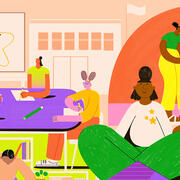“Students learn best in a psychologically safe, mistake-friendly environment. We all make mistakes. How teachers respond has everything to do with whether or not their students feel valued as human beings. We are responsible for creating a psychologically safe classroom. In all possible situations, we should seek to uphold the dignity of the student. Even when disciplinary action is necessary, it should be handled in a dignified way.”
— Chad Donohue, from “Give the Kid a Pencil”
Effective classroom facilitation is critical to supporting student learning and lessening behavior concerns. Teachers can spend hours crafting creative, engaging, standards-aligned lessons, but those lessons will be of little use if taught in a chaotic or unsafe learning space.
This classroom facilitation model seeks to reframe “classroom management” by questioning the assumption that teachers must always lead and be in control and that students must always follow. The toolkit supports educators in responding to student behavior with the goal of ensuring well-being and keeping learning on track rather than maintaining absolute control. It focuses on children’s development instead of punishment and offers proactive and inclusive practices to create affirming learning spaces.
Understand and Distinguish Behaviors
All behavior is communication aimed at meeting a need. While disruptive behavior may not be an appropriate way for a child to get their needs met, they engage in it because, on some level, it has worked for them. Determining the function of a behavior is essential for developing a response or intervention. Understanding the reasons behind behaviors also allows adults to focus on prevention, as opposed to punishment.
Not all behaviors call for the same response. For example, three common types of misbehavior — disrespect, disruption and disregard for rules (the “three Ds”) — indicate different needs and require different intervention strategies. Properly understanding and distinguishing behaviors also reduces the likelihood that educators will personalize student misbehavior.
Social scientists view behaviors as serving functions or purposes. Each child’s behavior is a puzzle that adults are tasked with solving. When we understand the function or purpose of a behavior, we can design interventions that teach children how to meet their needs in more appropriate ways.
The four most common needs driving behavior can be remembered by the acronym EATS.
- Escape: Children engage in inappropriate behaviors to try to escape a task or situation they find aversive.
- Attention: Children engage in inappropriate behaviors to gain — or escape from — the attention of peers or adults.
- Tangible gains: Children engage in inappropriate behaviors to gain access to a preferred activity or situation.
- Sensory needs: Children engage in inappropriate behaviors to meet a sensory or internal need.
Rethink Control and Power Dynamics
Reframing classroom facilitation requires an understanding of what is realistic to expect of a child. Our expectations should be based on what we know of the child’s personal circumstances, the message their behavior sends and their developmental level. Children enter classrooms with unique personalities and challenges; educators should consider these factors when assessing how to support children within the classroom community.
Adults have bad days and sometimes test boundaries, as we all know, but the expectations we place on children often don’t allow for these natural behaviors. Instead, we insist that children adhere strictly to our rules and allow themselves to be “managed.” The term “management” itself is problematic because it relies on unbalanced power dynamics and assumes that all children are developmentally the same and that the boundaries we establish adequately support the needs of all learners. “Management” also misplaces emphasis on training and control rather than collaboration.
Responsive classrooms are shared community spaces where children are growth partners and leaders of their own learning.
Be Proactive, Not Reactive
Proactive classroom culture calls for preventative steps, such as building relationships and fostering engagement, instead of reactive steps, like meting out punishment after misbehavior occurs. Simple strategies such as greeting children by name as they enter the classroom or engaging them in conversation about their interests outside of school, for instance, can have profound effects on behavior.
Responsive classroom facilitation honors the whole child, respects their identities and experiences, and acknowledges their critical role in the classroom community. It also seeks to understand behavior and make room for the varied ways children show up at school — the ways they express themselves and their needs — rather than focus exclusively on power and control.
Returning the classroom to order by any means necessary may seem desirable in the short term, but harsh or punitive practices actually exacerbate behavioral problems by fostering resentment and humiliation. Punitive practices also do nothing to change the environment or to address the underlying and unexpressed needs of the child. When educators engage in dialogue with children and create spaces where it is safe to make mistakes and learn from them, children are better equipped to understand and regulate their emotions and manage their own behaviors.
Practices To Foster Empathy
Empathy is the understanding of or the ability to identify with another person’s feelings or experiences. When we attempt to understand and relate to another person’s life, we are often more sensitive to what that person is experiencing and are less likely to tease or bully them. By explicitly teaching children to be more conscious of other people’s feelings, we can create a more accepting and respectful school and community.
1. Choose empathy. Empathy is not a feeling or a predetermined character trait; it is a choice to change our perspective. Discuss this choice with children. Engaging young people in experiences and circumstances different from their own helps them build bridges between misconception and understanding.
2. Understand that respect is subjective. Have a conversation with children about what respect means to them. Teachers and students might view respect differently based on expectations. For example, teachers might consider compliance as respect while students might think of not being embarrassed in class as respect.
3. Recognize that ways of showing empathy might differ. Sometimes young people — for example, those who are neurodivergent individuals — might express empathy in ways that seem different from what is usually expected or come across as not empathetic. Avoid judging a child’s ability to empathize, and instead seek to know and understand the child and their ways of experiencing and communicating.
4. Explain why you are there. Show passion. Explicitly explain to children that you are there to help prepare them for their future. Don’t be afraid to tell them about your own life. Letting young people in can help build their empathy as well as a mutually caring relationship.
5. Give an “I Wish You Knew” assignment. Giving young people ways to share about themselves can yield remarkable results. Children may not be comfortable sharing their thoughts in front of their peers or out loud, but they might be willing to write them down. Take time to reflect on what children want you to know and how that can inform your practice.
6. Model empathy. Work can be frustrating for many reasons, but adults should strive to always model empathy in interactions with children. Consider the empathetic perspective, described by Chad Donohue in “Give the Kid a Pencil,” as a means to push past frustration and toward unconditional understanding.
7. Reverse the Golden Rule. People have often used some version of the saying, “Do unto others as you would have them do unto you.” Rephrasing this as a question (i.e., “How would you feel if they did that to you?”) can help evoke empathy.
8. Incorporate immersion, problem-solving, group play and collaboration. Young people who work, solve problems and play together are more likely to empathize with others. Build these activities into a daily routine to allow children optimal time to practice empathy skills.
Teacher Habits That Support Student Development and Success
A teacher’s actions can build stronger relationships and foster positive classroom community. On the other hand, some habits can also negatively affect student behavior and undermine community. Educators should carefully examine habits, recognize the effects of their own behaviors, and make the essential choices to build positive culture.
1. Reflect on respect. Respect offers a strong foundation for classroom agreements because it can apply to the physical environment, instructional time, and peer-to-peer and teacher-student interactions. Respect, however, must be explicitly defined and agreed upon. Student definitions of respect often include teachers knowing their names (and pronouncing them correctly), not speaking down to them or embarrassing them in front of their peers, and expressing interest in their perspectives.
2. Consider the physical layout of the room. Step away from your desk and adopt a workspace from which you can easily see students, access materials and circulate to different parts of the room. Set up the space and arrangement to foster a collaborative environment. Consider the focus of the learning space as well as the images displayed on the walls, including tangible artifacts and celebrations of student learning.
3. Foster investment in the classroom culture. Strive for a classroom in which the teacher is a facilitator and leader, not a manager. Collaborative agreements, or mutually agreed-upon rules and guidelines, mean children have input on what is important and are a part of agreeing to it. Consider holding regular meetings during which the young people can hash out problems as a community and find solutions together.
4. Focus on the future. Who do the children want to be? Where are they going? Call them scholars, scientists, researchers and thinkers. Frame discussions around future successes.
5. Practice inclusivity. Make sure children know how important they are and that all of their identities are honored. Ensure that learning activities and the classroom environment are accessible, inclusive and supportive of all students. Speak up immediately when you witness bullying or hate speech of any kind.
6. Differentiate. Teaching styles and student needs, abilities and personalities vary too much for one-size-fits-all approaches. Give children a variety of ways to respond. Including movement, voice and rhythm is a cornerstone of culturally responsive teaching that can improve engagement and lessen discipline issues.
7. Reinforce positive behavior. Rather than praising the child themselves, praise their classroom-ready work and behavior. Be specific (“Good job finding your seat quickly.” “Thank you for sharing your crayons.”).
8. Plan classroom transitions. Student engagement and on-task behaviors can be influenced by how smoothly and efficiently teachers move from one learning activity to another. Prepare children with predictable routines and explicitly teach each step, multiple times if necessary. Many children need as much support learning behavioral skills as they do academic skills. Recognize and support children who struggle with transitions and may need more structure for stability. In planning transitions, think carefully about strategies and routines to support children’s safety and well-being rather than to reinforce compliance.
9. Examine your biases. Whether we’re aware of it or not, teachers are more likely to invoke negative stereotypes if the child is a person of color than if the student is white. LGBTQ+, class, gender and ability biases also affect perceptions of behavior and the ensuing responses.
10. Focus on development instead of punishment. Become a “warm demander.” Children have the most respect for teachers they can trust but who also hold them to high standards.
11. Understand and distinguish behaviors. The three Ds — disrespect, disruption and disregard for rules — indicate different needs and require different responses. Differentiate behaviors and respond accordingly.
12. Avoid the quick fix. Having a child removed from the classroom requires less effort than working with a counselor or other support staff to keep the child safely in class. Recognize that choosing the latter option will likely yield a more positive outcome for the child and keep them more connected to the learning environment.
Teacher Habits That Negatively Affect Student Behavior
1. Power struggles. If you engage in a public battle with a child, you have already lost.
2. Favoritism. A child who feels they have lesser status in the eyes of the teacher will respond accordingly. Withdrawal or misbehavior is often the result of not feeling respected or liked.
3. Hostile body language. Children are experts in nonverbal communication. Take an honest look at how your posture changes depending on how you’re feeling or to whom you’re speaking.
4. Restricting recess as punishment. Physical activity is important for all children, and exercise can particularly benefit students with attention-deficit/hyperactivity disorder (ADHD) — yet children with ADHD are among the most likely to have recess taken away.
5. Collective punishment. Holding children accountable when they were not part of the disruption undermines mutual respect in the classroom. Arbitrarily meting out punishment can cause children to feel insecure and distrustful.
6. Failing to forgive. Children should be able to redeem themselves, correct their behavior and rejoin the classroom community. Start each day new and without judgment about the past.
7. Personalizing student behavior. Behavior is most accurately viewed as communication about a child’s needs, not a personal statement about an educator’s teaching or personality.
8. Exempting yourself from the rules. In a collaborative classroom, the rules apply to everyone. Don’t talk on your cell phone or eat in class if these behaviors are against the rules for children.
9. Making too many rules. A classroom that is too rigid will demoralize children and can even lead to rebellion. Keep the list of rules clear, broad and short.
10. Passing the buck. Resolve as many issues as possible in the classroom. Sending children to the office or another room relinquishes your power as the instructional leader. Children need to receive the message that you care about resolving issues within the classroom community.
11. Setting low expectations. Given the opportunity, children will rise to the occasion. Critical engagement requires establishing rigorous standards for all children and providing the scaffolding necessary for them to succeed.
12. Public shaming or reprimanding. Whenever possible, avoid embarrassment and further disruption by resisting the urge to discipline a child in front of the class. Instead, try talking one-on-one. If another child is the victim of the behavior, make it known publicly that the behavior will be addressed. Consider using restorative justice, which brings the person who is harmed into the discussion, allowing students to take ownership over classroom culture and make amends as needed, and restores misbehaving students to the classroom community. (Note: Be sure to get support and training for executing restorative justice practices before implementing them for the first time.)
Ways To Redirect Disruption
1. Refocus the energy. Instead of pausing teaching to reprimand, ask the misbehaving child to answer a lesson-related question — one that you know they will be able to answer so that the strategy doesn’t lead to humiliation in front of peers. This engages the child, gets them back on task, and keeps the pace of the lesson moving forward without taking the focus off learning.
2. Give students a break. Have a disruptive child take a physical break or a break from the current assignment. Ask the child to move seats or give them a special responsibility or errand.
3. Give nonverbal cues. Eye contact and body language are effective communication tools — if handled with sensitivity. A gentle hand on a desk, catching a child’s eye and circulating throughout the classroom all have the power to help children refocus and stay on task. Open, nonthreatening body language tells children you are calm and in control of the class — and also that you see them, care about them and want them to do better. Be sensitive to the ways in which different cultures regard eye contact and physical proximity between adults and children.
4. Address the disruption quickly and quietly. Get the class focused on another task and speak with the child to the side. Start with a statement or question that is not accusatory, like, “It looks like you may have a question,” or, “What’s up?” Then, remind the child of the rules and assignment and direct them back to work with an expectation. If a child is engaging in the behavior to seek attention, drawing focus away from the behavior will likely cause it to stop.
5. Offer kinesthetic movement options. Many children (and adults) benefit from some sort of kinesthetic movement while listening to instructions. If a child is squirming or making noise, hand them a stress ball, fidget cube, piece of Velcro or other sensory stimulus to help them stay on task.
Alternatives to Removal
1. Schedule a one-on-one conversation. By having a quiet, uninterrupted time for discussion, you can not only address behavior with the child but also give them the opportunity to talk about their frustrations or other issues that may be affecting their behavior.
2. Call home. Make time to call the family together and explain the behavior as well as any actions that you or the school plan to take as a result. Make sure you have previously established a relationship with parents and caregivers and are sensitive to their work schedules when calling. Be sure that you have called home to share the child’s successes or that you have regular communication with parents and caregivers that is not focused on misbehavior. Focus the conversation on collaborative solutions rather than seeking caregiver involvement in punishing the child or “fixing” the problem.
3. Send a “next-time” message. Frame responses in a manner that corrects the child’s behavior without shame or discouragement. Remind children what to do next time instead of focusing on what they just did. “Next time, come talk to me about the problem you are having with a classmate.”
4. Offer time for mindfulness. Teach children how to calm down, breathe and focus their energy. Learning these skills will help children reflect on their behavior and be prepared to reengage with the classroom and the content. Mindfulness can be done in a safe space, like a classroom peace table, or as part of a daily routine.
5. Use restorative justice. If a child’s misbehavior targets another child or harms the larger class, create the opportunity for the targeted student(s) to express how the behavior affected them and for the student who has harmed to make amends. (Note: Be sure to get support and training for implementing restorative justice.)
6. Refer to mental health or support services. Find out who provides mental health services at your school. If these services aren’t available, find out what resources the district or the community has to offer. Let families know you are available to help formulate goals related to behavior you’ve witnessed at school.



